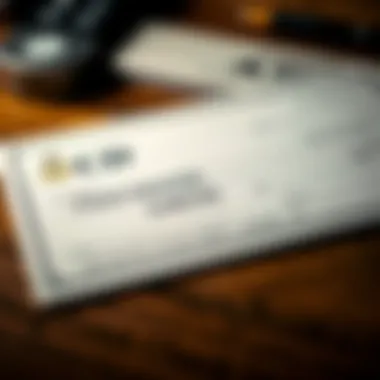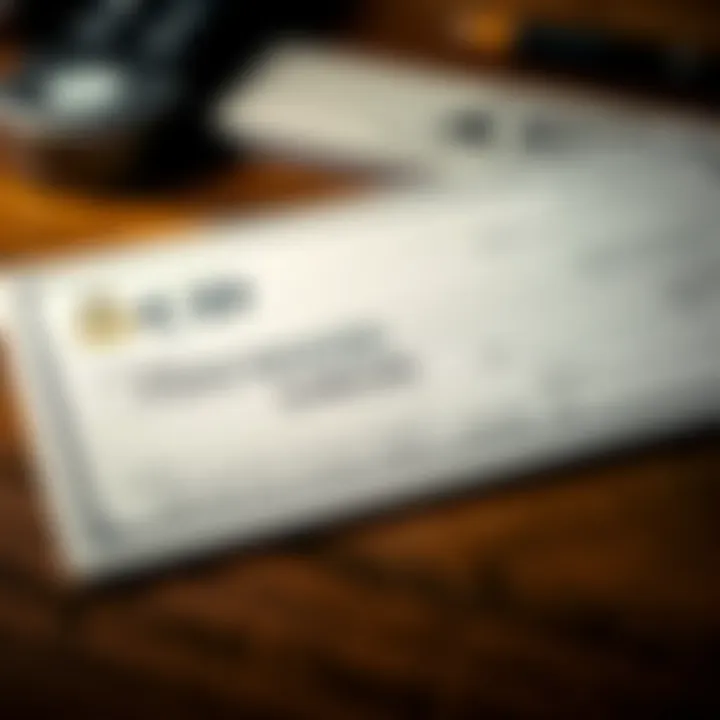Understanding Certified Checks: Key Insights and Use


Intro
Financial transactions come with various instruments that facilitate trade. Among these, certified checks often stand out due to their security and reliability. For both buyers and sellers, understanding how these checks work is essential in making informed decisions. In this piece, we will dissect the nuances of certified checks—what they are, how they function, and the crucial considerations one should keep in mind.
Key Financial Concepts
Terminology Breakdown
A certified check is not just any ordinary check. It represents a promise from a bank that the funds are available and have been allocated for the specific transaction. This guarantee is particularly advantageous for large purchases where trust between the involved parties is paramount.
Here are some key terms associated with certified checks:
- Drawer: The individual who writes the check.
- Payee: The recipient of the check.
- Bank Certification: The bank's acknowledgment that the funds exist and that they have earmarked them for payment.
- Verification Process: Steps taken by the bank to ensure legitimacy of funds before issuing a certified check.
Understanding these terms provides a solid foundation for grasping how certified checks function within the financial landscape.
Understanding Market Trends
Recent trends indicate a growing preference for certified checks, particularly in real estate and high-value transactions. In recent years, people have turned away from cash and personal checks, favoring the security that comes with certified funds. According to the Federal Reserve, the volume of checks written has generally declined, but certified checks seem to maintain a steady demand.
Additionally, as more people engage in online transactions that involve significant sums, the need for secure payment methods is paramount. Certified checks serve as a bridge between convenience and reliability, effectively addressing concerns about fraud that are prevalent in today's market.
Product Analysis
Comparative Ratings
In comparing certified checks to other types of payment, several distinguishing factors become clear:
- Security: Unlike standard personal checks, certified checks can’t bounce due to insufficient funds. They offer a layer of protection.
- Speed of Funds Availability: While a personal check may take several days to clear, a certified check typically guarantees faster processing.
- Cost: Usually, banks charge a fee for issuing a certified check, which adds a small cost to the convenience it provides.
Expert Reviews
Financial experts often highlight certified checks as a viable option for serious transactions. A review on Investopedia suggests that the transparency and reliability of certified checks make them preferable for many consumers. Though alternatives like cashier's checks and money orders exist, certified checks often shine due to their traceability and the backing they receive from banks.
"Certified checks are often used when large sums are involved, minimizing risks related to fraud and ensuring a smoother transaction process." - Financial Analyst, Investopedia
In the realm of lending, certified checks are appreciated for their clarity and potential to expedite loan closures, making them a valuable tool for financial advisors and their clients alike.
Epilogue
Arming oneself with knowledge about certified checks elevates financial literacy. Whether investing in real estate, purchasing a vehicle, or conducting any high-value transaction, understanding their function and the implications of using them is vital. Given their advantages in terms of security and reliability, certified checks hold a significant place in modern financial interactions. For further details, you can refer to resources like Wikipedia or trusted financial blogs where the nuances of such instruments are discussed in depth.
Defining a Certified Check
Understanding the nature of certified checks is vital in grasping their role in financial dealings. A certified check, at its core, represents a promise backed by a financial institution. This is not merely a signed piece of paper; it carries weight and reassures both the payer and the payee of its validity. With the rising incide based on financial disputes, knowing what a certified check is can be the difference between a smooth transaction and a potentially messy situation.
When an individual opts for a certified check, they are essentially bringing a layer of security and assurance to monetary exchanges. This understanding is important, particularly for transactions involving larger sums where personal checks might not suffice. Moreover, having a clear definition sets the platform for discussing not just how these checks work, but also the considerations surrounding them.
What Precisely is a Certified Check?
A certified check is a type of check for which the bank verifies that the account holder has sufficient funds to cover the amount written. Once this verification happens, the bank will ‘certify’ the check, meaning it guarantees the funds’ availability at the time the check is presented. This certification effectively seals the deal by safeguarding the recipient against the risk of the check bouncing.
In layman’s terms, if you receive a certified check, it’s like the bank gives you a thumbs up that the funds are indeed there and will be paid out once the check is deposited or cashed. This makes it a favored option for situations that demand assurance—the sale of a vehicle or a down payment on a house, for instance. It's much easier for both parties to trust a certified check because of the security it brings.
Differences Between Personal and Certified Checks
When comparing a certified check with a personal check, there are several key distinctions that come to light:
- Guarantee of Funds: A certified check ensures that the funds are there and promises to pay the recipient once deposited. Personal checks, on the other hand, depend on the payer’s balance, which might fluctuate.
- Issuance Process: A certified check is issued by a bank after the customer requests it and it goes through a verification process. Conversely, anyone with a checking account can write a personal check without external validation.
- Security Features: Certified checks typically incorporate security measures, making it harder to forge them. Personal checks can be easier to duplicate or alter if security isn’t taken into account by the issuer.
Just picturing the differences clears a lot of fog for those stepping into financial transactions or when choosing between these two methods. When it comes to reliability in payments, clearly, the skies look brighter for certified checks.


A certified check acts like a shield for both money and trust in the world of finance, strengthening transactional integrity.
The Process of Obtaining a Certified Check
Obtaining a certified check is not just a mere formality; it represents a critical step in financial transactions where trust and verification play vital roles. For individuals and businesses alike, understanding this process equates to ensuring the security and reliability of their monetary exchanges. The importance of knowing how to acquire a certified check cannot be overstated, as it can safeguard against potential payment issues and fosters confidence in dealings that otherwise might be fraught with uncertainty.
When you embark on the path to request a certified check, you engage in a series of steps that realize not just a simple transaction, but rather the formalization of financial responsibility and accountability.
Steps to Request a Certified Check
Requesting a certified check involves several straightforward steps, yet they require attention to detail. Here's a concise rundown to guide you through the process:
- Visit Your Bank or Credit Union:
Head to the institution where you hold your account. While some banks offer online services, an in-person visit is often the most straightforward option to start with. - Inquire About Fees:
Often, banks will charge a service fee for the issuance of a certified check. It’s essential to ask about any costs involved upfront to avoid potential surprises. - Present Identification:
Bring a valid form of identification such as a driver’s license or passport. This confirms your identity and aligns your request with bank policies. - Provide the Amount Needed:
Specify the amount that you want the check to be certified for. This is where precision matters; ensuring that it matches the payment required for the transaction at hand. - Complete Necessary Paperwork:
You may need to fill out a request form or provide reason for the check. This paperwork helps the bank adhere to regulatory standards. - Receive Your Certified Check:
After processing, you will receive your check with an official bank stamp, indicating that the funds are secured. Always check the details, ensuring names, amounts, and signatures are correct.
Following these steps can minimize anxiety and streamline the often tedious process of securing a certified check, making it as efficient as possible.
Necessary Documentation for Issuance
As with any financial transaction, proper documentation underpins the issuance of a certified check. Not having the right papers can lead to unnecessary delays or complications. Here’s what you’ll typically need:
- Valid Identification:
This could be a government-issued ID that has your picture and confirms your identity. It's your passport into the banking system for this transaction. - Account Information:
Have your checking or savings account number ready. This identification connects the funds to your bank account. - Funds Availability:
Ensure you have sufficient funds in your account to cover the check's amount. This isn’t merely a formality; it’s a crucial step in preventing any transaction issues further down the road. - Transaction Purpose:
Sometimes banks may ask for a brief description of what the funds are intended for. While not always mandatory, having this information at hand can smoothen the process.
In summary, being prepared with the necessary documentation can make the process significantly less cumbersome and lay the groundwork for a transaction that you can trust.
For further information on certified checks, resources such as Wikipedia and Britannica provide in-depth insights.
Understanding the Mechanics of Certified Checks
Understanding the mechanics of certified checks is vital for anyone looking to navigate the financial landscape effectively. This section sheds light on how funds are secured and verified, which is crucial in ensuring both safety and reliability in transactions. Additionally, the banking institutions play a significant role in this process, and grasping their function can enhance one’s understanding of certified checks overall. To avoid pitfalls while using such instruments, it's imperative to delve into these aspects in detail.
How Funds are Secured and Verified
When it comes to certified checks, the security of funds is paramount. Unlike personal checks, a certified check assures the recipient that the funds are both available and will be honored. Here's how this process typically operates:
- Fund Verification: Once a certified check is requested from the bank, the bank verifies that the funds are available in the account. This verification can include checking the account balance and may involve freezing the specified amount.
- Certification Process: After validating the availability of funds, the bank certifies the check. This means that the bank officially acknowledges that the funds are reserved for the check, preventing the account holder from withdrawing those funds until the check clears.
- Bank Endorsement: The bank then stamps the check with a certification mark, which indicates that it is a certified check. This endorsement serves as a guarantee to the recipient that they can cash or deposit the check without concerns of it bouncing due to insufficient funds.
“A certified check is like having an insurance policy on your payment—it signifies security to both the buyer and receiver.”
The Role of the Banking Institution
Banks are an integral part of the certified check ecosystem. Their responsibilities go beyond simply processing transactions; they act as a trust intermediary between the payer and the payee. Here's how banks fit into the picture:
- Liability and Risk Management: Banks take on the responsibility of validating funds and ensuring accuracy in transactions, thus reducing the risk associated with check fraud.
- Documenting Transactions: They maintain records of all certified checks issued. This documentation can be vital for dispute resolution or if issues arise later.
- Facilitating Trust: The endorsement by a bank gives both parties peace of mind. It fosters confidence, knowing that a regulated financial institution stands behind the transaction, rather than relying on an individual’s promise to pay.
In sum, understanding the mechanics behind certified checks helps investors, financial advisors, analysts, educators, and students make informed choices in the realm of financial transactions. This knowledge not only enhances one’s ability to utilize certified checks effectively but also contributes to safer and more reliable financial dealings.
Certified Checks in Financial Transactions
Certified checks play a pivotal role in financial transactions, providing a layer of assurance that both buyers and sellers greatly value. They bridge the gap between what is often a high-stake transaction and the need for security. The significance of certified checks goes beyond their functionality; they embody trust in a world where scams and dishonesty can be rampant. Thus, their presence in financial dealings is essential, especially in situations where larger sums of money are involved.
The functionality of certified checks often reveals itself in multiple scenarios, which we shall explore below. The core value lies in their ability to secure payments, guarantee funds, and offer peace of mind to parties involved. This is particularly notable during real estate transactions, car purchases, and other high-value dealings where being left in the lurch can lead to substantial financial loss. In the subsequent sections, we’ll delve deeper into specific instances where certified checks prove advantageous, further illuminating their importance in financial transactions.
Common Scenarios for Using Certified Checks
Certified checks are often the go-to choice in various common scenarios due to their nature. Here are a few of the prominent situations that typically warrant their use:
- Real Estate Transactions: Whether buying or renting, certified checks are frequently required to secure deposits or down payments. They assure sellers of the buyer's serious intent and financial capability.
- Vehicle Purchases: For both private sellers and dealerships, utilizing a certified check ensures a buyer's funds are guaranteed. This reduces the chances of a sale falling through due to insufficient funds.
- Business Transactions: In commercial agreements, where large sums might change hands, certified checks are preferred for their reliability. Business owners often utilize them for vendor payments or settling debts.
- Legal Transactions: Lawyers often request certified checks for retainer fees or settlements to ensure that funds are clear and guaranteed before proceeding with legal matters.
In all these instances, the role of a certified check helps facilitate smooth transactions and mitigates the risk of payment disputes, making them invaluable in today's transactional landscape.
Advantages of Using a Certified Check


The use of certified checks yields several benefits that make them a smart choice for many financial situations. Here are some notable advantages:
- Assured Payment: A certified check comes with a bank's guarantee, meaning that the funds are set aside specifically for that transaction. This diminishes the risk of bounced checks, thus providing confidence to the recipient.
- Protection Against Fraud: Given the stringent protocols banks use in issuing certified checks, the risk of fraud is significantly reduced. This adds a layer of safety that personal checks and money orders may not offer.
- Easier Reconciliation: Businesses often find it easier to manage their books when they receive certified checks. The guaranteed nature helps in streamlining accounting processes, reducing discrepancies.
- Widely Accepted: Banks, real estate agents, and businesses tend to favor certified checks over personal checks. Their acceptance helps in expediting transactions and minimizes timelines.
Overall, while they might not be as common in day-to-day transactions, certified checks serve a specific need in the financial industry, ensuring parties enter transactions with mutual confidence and security.
Potential Risks and Drawbacks
In the world of finance, understanding the nuances of any transaction method is crucial. Certified checks, often viewed as a secure alternative to personal checks or cash, offer various advantages, but they are not without their pitfalls. Recognizing these potential risks helps individuals make informed decisions, particularly in significant financial dealings. Grasping the drawbacks of certified checks is just as vital as their benefits, for they reside in the grey zone of security and service, making it essential for users to tread carefully.
Common Issues with Certified Checks
Navigating the landscape of certified checks comes with its fair share of complications. One prevalent issue is the potential for discrepancies between the amount written on the check and what the bank has committed to. Miscommunication between parties can lead to confusion, especially if the check is issued for different terms than discussed prior. For instance, when purchasing a vehicle, a seller may expect a specific amount that does not align with what’s on the check. Such mistakes can not only lead to conflicts but also to delays that can frustrate both parties involved.
Additionally, unlike cash transactions, certified checks can bounce in rare cases, nearly akin to personal checks if the funds weren’t available or if the account had overdrawn amounts. This situation brings a host of legal and financial implications into play. If a certified check returns unpaid, it might tarnish the credibility of the individual who issued it, leading to both reputational damage and financial repercussions.
The adoption of electronic methods and online payment avenues, like wire transfers or e-checks, have further complicated the use of certified checks. With many merchants opting for more instantaneous forms of money transfer, certified checks may come across as outdated, not to mention cumbersome as they involve additional trips to the bank.
Fraud: Identifying Red Flags
Fraud is a significant concern when dealing with certified checks, and identifying potential red flags can save individuals from substantial losses. Firstly, be wary of unsolicited offers that involve certified checks; these generally fall into the category of scams. Scammers often send checks for inflated amounts, instructing individuals to withdraw the excess and send it back. Simply put, if a deal sounds too good to be true, it probably is.
Secondly, examine the physical check itself closely. Genuine certified checks display certain features such as watermarks or specific logos. Lack of these security features can be a warning sign. Remember, verification is vital. Always check with the issuing bank to ensure its authenticity, especially if you have any doubts about its source or the transaction involved. Should a friend or acquaintance offer a certified check for a high-value item, proceed with additional scrutiny.
To sum it up, while certified checks can act as a safeguard in transactions, they are not immune to misuse. Always consider the context of their use and stay alert to any signs that may indicate fraud or discrepancies.
Takeaway: Whether you are engaging in a property purchase or settling high-stake deals, understanding the risks associated with certified checks is essential for avoiding pitfalls and ensuring smooth financial transactions.
For further information regarding certified checks and their applicability, you can refer to resources such as Wikipedia or seek insights on platforms like Reddit.
Comparing Certified Checks with Other Payment Methods
In today’s fast-paced financial landscape, individuals and businesses alike must navigate an array of payment methods. Comparing certified checks to other forms of payment is vital to understanding their unique role in the world of transactions. This section will shed light on how certified checks stack up against other options, namely money orders, cashier's checks, and personal checks. Each method has its own set of characteristics that makes it suitable for different scenarios.
Certified Check vs. Money Order
When it comes to certified checks and money orders, both instruments serve the purpose of guaranteeing funds, yet they differ considerably in their mechanics and applications.
A certified check is issued by a bank with the assurance of payment from the account holder, effectively confirming the existence of sufficient funds. This is generally seen as a solid guarantee of payment, given that banks perform their due diligence before issuing the check. On the other hand, a money order can be purchased at various locations, including post offices and grocery stores, often without the need for a bank account.
The cost factor also varies; while money orders typically have lower fees compared to the costs associated with obtaining a certified check, they usually come with a maximum limit. For instance, you might find that money orders are limited to amounts around $1,000, which makes them less suitable for high-stake transactions.
In summary:
- Certified checks offer higher payment assurance, essential for significant transactions.
- Money orders are accessible to individuals without bank accounts but come with transaction limits.
Certified Check vs. Cashier's Check
In the realm of secured payments, cashier's checks are often grouped together with certified checks, yet there are subtle differences between them.
A cashier’s check is drawn against a bank’s own funds, offering a higher level of security. The bank guarantees payment, which makes it extremely reliable. In contrast, while a certified check carries similar weight, it is tied directly to the individual account holder’s funds. Thus, there’s a slight risk (although rare) associated with certified checks, especially if the account holder's situation changes.
Another point of distinction is processing time. Cashier's checks are often quicker in many instances due to their backing by bank funds. This immediacy can become crucial during time-sensitive transactions, which adds to their appeal.
Key points to consider:
- Cashier's checks are backed by bank funds, offering very secure transactions.
- Certified checks are dependent on the account holder's funds, adding a layer of risk.
Certified Check vs. Personal Check
When it comes to certified checks versus personal checks, the differences are stark and far-reaching.


Personal checks can be risky in that they rely solely on the issuer's account balance and may bounce if the funds are insufficient. This creates a period of uncertainty in transactions, where an accepted personal check can easily lead to potential losses. By contrast, certified checks provide a solid guarantee that funds are available, addressing the risk factor head-on.
Moreover, the acceptance of personal checks is dwindling in many settings, as vendors and service providers often view them as less reliable. A certified check, due to its bank-backed assurance, holds more weight and is more widely accepted in formal transactions.
To put it simply:
- Certified checks are secure and widely accepted, making them suitable for large or important payments.
- Personal checks are widely used but carry inherent risks, limiting their acceptance in certain situations.
Best Practices for Using Certified Checks
When it comes to navigating the often murky waters of financial transactions, understanding how to properly use a certified check is invaluable. Not only does this payment method provide security and reliability, but it also carries certain expectations and responsibilities for both the payer and the payee. In this section, we shall delve into best practices that elevate the safe and effective utilization of certified checks, ensuring both parties remain protected.
Steps to Ensure Safe Transactions
- Know Your Issuer
Before engaging in any transaction with a certified check, it’s imperative to confirm the legitimacy of the issuer. Whether it's an individual or a business entity, verifying their credibility can save you a lot of headaches down the line. Always consider getting references or checking online reviews if the issuer is not someone within your circle. - Always Meet in Person
Whenever possible, opt to meet the person issuing the certified check face to face. This direct interaction is not only a great way to establish trust but also helps in identifying any red flags about the transaction. Check the signature against an ID, and, if feasible, invite a witness along to bolster the process. - Keep Copies
For your records, maintain a copy of the certified check. Documentation can be a lifesaver should any disputes arise later. This serves as evidence of the transaction, especially when confirmation from your bank is involved. - Understand Payment Amount and Details
Make sure the certified check is for the agreed amount only. Double-check that the details provided on the check, including dates and names, are accurate. Errors might complicate deposits or cause misunderstandings.
"A stitch in time saves nine. Make sure all details are correct before finalizing your payment."
- Be Cautious with Larger Amounts
If you find yourself dealing with sizable sums, it might be worthwhile to carry out more extensive due diligence. If necessary, consider involving a legal authority or a notary to certify the transaction and bolster security.
Verifying the Authenticity of Certified Checks
The last thing anyone wants is to inadvertently fall victim to a scam involving fake certified checks. Here are some steps to ensure you aren’t left holding the bag:
- Check the Watermark
Authentic certified checks often contain specific security features such as watermarks that are only visible when held up to the light. Make it a habit to inspect for these features immediately upon receiving a check. - Contact the Issuing Bank
One surefire way to confirm authenticity is by contacting the bank listed on the certified check. Use a verified phone number obtained independently, rather than relying on any contact details found directly on the check. This ensures you aren't speaking to anyone who might be in on the scam. - Look for Signs of Alteration
Upon examining the check, check whether the check has been altered in any way. This could include smudged printing, irregular characters, or even different fonts. Any unusual observations should raise a red flag and prompt further investigation. - Use Check Verification Services
Numerous organizations offer check verification services that can validate whether a check is valid or not. These services usually charge a fee but can provide an extra layer of security. - Trust Your Instincts
Often, the intuition of experienced individuals carries weight. If something feels off about a transaction, it's perfectly acceptable to decline or postpone until you feel more secure about proceeding.
By following these best practices, not only do you protect yourself during financial transactions, but you also foster an environment of trust and reliability within your dealings. Using certified checks wisely opens up a secure avenue for transactions that can serve you well in the long term.
Handling Issues with Certified Checks
Navigating financial waters can be tricky, especially when dealing with certified checks. Understanding how to handle issues that arise with these checks is crucial. In today's financial landscape, disputes and complications can surface, often out of the blue. Whether you're the payee or the issuer, awareness of what to do during such times is key to protecting your interests.
In this section, we'll delve into two significant aspects: what steps to take if a check bounces, and the dispute resolution process related to certified checks. Being prepared can save you headaches and potentially financial losses down the line.
What to Do If a Check Bounces
First off, if you find yourself in the unfortunate position of a bouncing certified check, don’t panic. Although it's not an everyday occurrence, it can happen for various reasons, like insufficient funds or a bank error. Here's how to address it:
- Contact the Bank: Right at the bat, reach out to the bank from which the check was issued. They can give insights into why the check bounced.
- Verify Funds: Confirm if there were indeed sufficient funds at the time the check was issued. If funds were available, a discrepancy could indicate a mismanagement issue on the bank's part.
- Notify the Payee: Let the person or entity you issued the check to know about the situation. Transparency ensures that both parties remain informed and can make necessary arrangements.
- Reissue the Check: If the only issue was a bank error and funds were indeed available, consider reissuing the check. But, ensure you handle this carefully—check all details and consider using a different payment method if it seems prudent.
- Document Everything: Keep detailed records of all communication and transactions related to the check. This documentation will be essential if you need to take any further action.
By following these steps, you can navigate a bouncing certified check with relative ease. But remember to stay calm and organized—it makes a world of difference.
Dispute Resolution Process
If you're in a situation where there’s a substantial disagreement about a certified check, knowing the dispute resolution process can be invaluable. The primary steps usually involve:
- Identify the Issue: Are you facing a case of non-payment or an incorrect amount? Pinpointing the exact nature of the dispute is the first step in finding a solution.
- Gather Evidence: Collect all relevant documentation. This includes the certified check itself, any correspondence, bank statements, and records of the transaction. The more evidence you have, the stronger your case.
- Direct Communication: Reach out directly to the party involved. Sometimes, misunderstandings can be easily resolved through a straightforward discussion.
- Involve the Bank: If the issue persists, bring the bank into the mix. They can often mediate and provide a neutral perspective on the situation. Since they issued the check, they have an obligation to help ensure the transaction's integrity.
- Seek Legal Advice: If all else fails, it might be time to engage a legal professional. Laws surrounding financial transactions can vary by jurisdiction, and a lawyer can help navigate these complexities more effectively.
Overall, handling issues with certified checks can seem daunting, but having a clear plan can alleviate some of that pressure. Knowing the steps to address bounced checks and disputes gives you an advantage in resolving financial hiccups efficiently. Keeping communication open and gathering all relevant documentation is the best path toward a satisfactory resolution, whatever the issue may be.
End
The topic of certified checks is pivotal in the realm of financial transactions, particularly for investors, advisors, and anyone engaging in significant monetary exchanges. It encapsulates not just a method of payment but also a layer of security and trust in dealings. As we draw this discourse to a close, let’s underscore the significance of having a strong grasp on certified checks, their workings, and their implications.
Summary of Key Points
- Definition and Functionality: A certified check is backed by the issuing bank, which guarantees the funds. This distinction from personal checks is essential, as it provides assurance for transactions.
- Process of Acquisition: Understanding how to properly request and obtain a certified check is crucial. This involves specific steps and required documentation that can streamline your experience.
- Mechanics of Security: Grasping how funds are secured and verified is fundamental. The banking institution plays a key role in confirming the availability of funds before issuing the check.
- Practical Applications: Certified checks are commonly used in large purchases, real estate transactions, and business contracts. Recognizing when and why to utilize them can prevent potential complications.
- Risks and Best Practices: Both potential pitfalls associated with certified checks and strategies for safe transactions have been examined. Individuals must remain vigilant for signs of fraud and take steps to verify the legitimacy of certified checks.
Final Thoughts on Certified Checks
In a world where digital transactions are becoming increasingly common, understanding traditional methods like certified checks plays a crucial role. They are not merely outdated relics but important tools that fulfill specific needs in various financial situations. The guarantees offered by a certified check can bolster confidence in both parties during a transaction, thereby enhancing trust.
Furthermore, as financial landscapes evolve, being knowledgeable about all payment methods, including certified checks, allows individuals to make informed decisions. This understanding empowers buyers and sellers alike to navigate financial exchanges with assurance, potentially avoiding scams and misunderstandings.
"Knowledge is power, especially in the domain of finance. Always stay informed and never underestimate the importance of every payment method available - including certified checks."
For additional information, consider checking resources such as Investopedia or Khan Academy.
This synthesis of knowledge accrued throughout this article aims to enlighten you regarding not just how certified checks function but also their broader implications in your financial journey.















